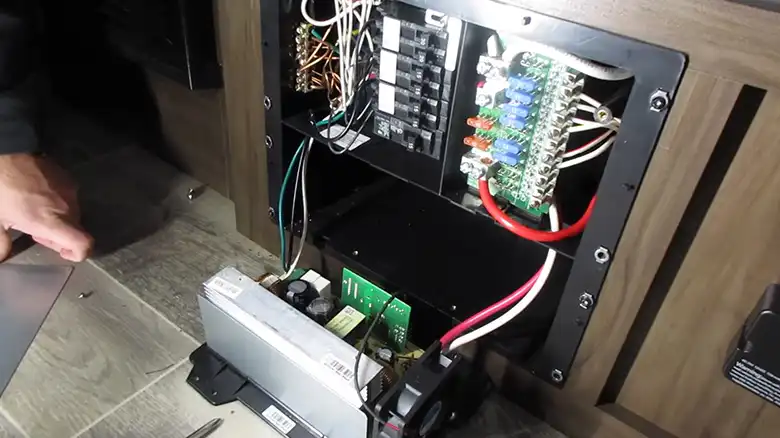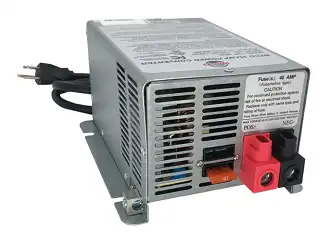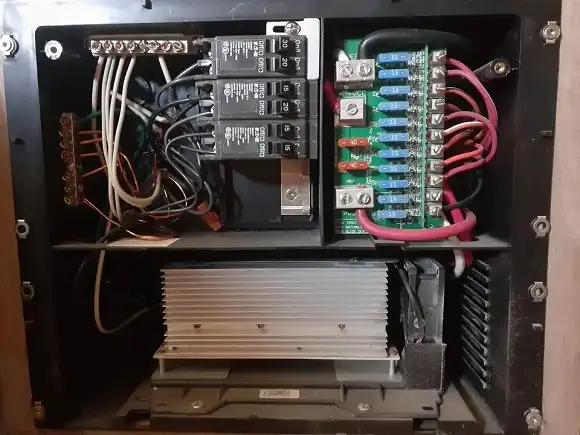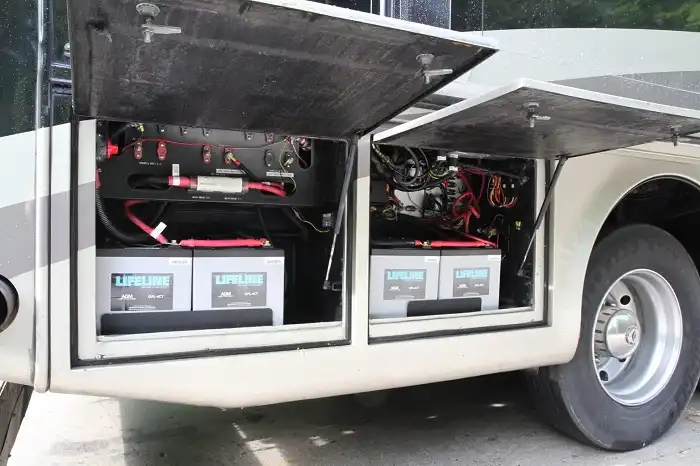WFCO power converters play an integral role in RV electrical systems. Installed in RVs, fifth wheels, and travel trailers, these converters transform 120V AC shore or generator power into 12V DC electricity to recharge onboard batteries and power DC appliances and lights. However, converter failure or malfunction can disrupt this critical charging functionality.
This comprehensive guide I prepared, will explore the various causes and solutions if you find your WFCO converter unable to effectively charge your trailer or RV battery.

How WFCO Power Converters Function in RVs?
Before diving into troubleshooting, let’s briefly review how WFCO converters function in recreational vehicles:

- Converts 120V AC shore/generator power to 12V DC electricity
- Recharges house battery when connected to shore power or running generator
- Powers 12V DC lighting fixtures and appliances
- Automatic, integrated charging functionality
An issue with any part of this system can cause charging problems. Now let’s explore why your WFCO converter may fail at recharging your battery.
Common Causes of WFCO Converter Not Charging and How to Fix Them
Several issues can prevent a WFCO converter from delivering a charge to your battery. We will cover the most common culprits and how to diagnose them.
Blown Fuses
The first thing to check is the fuses connected to your converter’s output and charging circuit. Depending on your WFCO model, inspect the fuse blocks by the converter box itself and along the charging wire path to the battery. Refer to your WFCO manual to identify fuse locations.

Examine all fuses related to the converter charging function. Look for any that appear blackened or have a broken filament inside indicating they have blown. Using a continuity tester or multimeter can also help detect if fuses have continuity.
Replace any blown converter or charging circuit fuses with identical replacements of the matched amperage and voltage rating. Be sure to disconnect shore/generator power before servicing fuses.
Loose Wire Connections
Loose wiring that powers your converter or connects it to the RV battery can also disrupt the charging functionality.
Physically inspect wires for any loose screw terminals, unplugged connectors or visibly damaged cables or adapters along the charging circuit. Pay particular attention to the battery terminals and ground wiring. Even small amounts of looseness can prevent sufficient power transfer for charging.
Gently wiggle connectors and cables to check for internal breaks or corrosion. Tighten any loose screw terminals or plugs. Replace severely corroded wires or terminals. Ensure adapter pins make flush contact. Confirm shore power cable has no damage.
Faulty Power Converter
The WFCO converter itself may fail causing charging issues. Some common symptoms signaling it is faulty include:
- No output voltage on converter terminals
- Unusual noise from converter box
- Signs of internal overheating and burnt components
- Converter not powering 12V DC appliances/lights
First, check the converter box ventilation and let the unit cool if overheats. Then use a multimeter to check the output voltage on the converter DC terminals. No or abnormal output could indicate converter failure.
Inspect closely for any damaged, burnt, or leaking components inside the converter case. Consult manufacturer troubleshooting tips. You may need to ultimately replace the faulty converter based on model-specific compatibility.
Battery Not Holding Charge
Before replacing other parts, ensure the RV battery can actually hold a charge. As batteries naturally degrade over time, they may reach the end of their lifespan and resist taking current.

Using a battery load tester, apply a controlled load across the battery leads. This simulates high discharge similar to converter charging. Monitor voltage drop over time – sharp decreases indicate a weak or dying battery unable to stay charged.
Checking a flooded lead-acid battery’s specific gravity with a hydrometer is another validation method. Very low readings in multiple cells usually mean it’s time to replace the worn-out battery. Top up any low fluids first before testing.
Consider replacing an old degraded battery that fails charging tests. Or research options to recondition the battery through controlled charge/discharge cycles.
Incorrect Converter Configurations
Some WFCO converter models allow adjusting configurations that impact charging functionality. Ensure settings align with your actual battery setup:
Battery type – Confirm converter setting matches actual installed battery chemistry (e.g. flooded, AGM, gel, lithium)
Charge rate – For large battery banks, make sure the converter charge current aligns with the capacity
Refer to the specifications sticker on the battery itself and cross-reference with the converter technical manual as needed to validate optimal settings. Adjust configurations through the converter interface if discrepancies are found.
Preventative Maintenance Tips for WFCO Converters
Beyond resolving an immediate charging issue, regular maintenance and proper storage also help minimize converter and battery problems overall.
Inspect Electrical System – Periodically check converter and battery wiring for loose connections or corrosion buildup – both can gradually disrupt charging over time. Clean terminals and secure connectors as preventative care.
Monitor Performance – Note any gradual decline in charge efficiency which may indicate impending failure. Catching problems early better protects batteries and equipment.
Follow Storage Best Practices – During long-term RV storage, use a smart charger to maintain optimal battery charge level without risk of overcharging. Disconnect batteries are likely to drain over time. Allow converter ventilation.
Consider Upgrades – When coping with an aging converter paired with newer battery chemistry, research available replacement or retrofit options that improve charging compatibility.
Step-by-Step WFCO Converter Replacement Instructions
Expect to spend $200-500 to purchase a new WFCO power converter, depending on the exact model and power capacity required. Smaller, basic RV converters start around $200 while larger, premium models run up to $500.
How to Replace WFCO Converter?
Installation is straightforward but does require basic electrical knowledge. First, turn off the shore and generator power to the RV. Then remove the existing converter box by disconnecting all wiring from terminals and unfastening any mounting brackets or bolts. Carefully extract the converter and discard it appropriately.
Align and secure the new WFCO converter unit in place using mounting holes and ensure ventilation openings remain unobstructed. Attach wiring to appropriately matched terminals – typically positive and negative battery cables, 12V outlet wires, and shore power input cables. Ensure the ground wire is fastened securely.
Turn the power back on and test the operation of lights and appliances using shore or generator power. Use a multimeter to verify converter is outputting 13.6V DC. Finally, let the battery charge completely to confirm normal charging functionality is restored.
When to Seek Professional RV Technician Help
While many converter charging issues can be corrected through troubleshooting and DIY repair, more complex electrical problems affecting the converter may require an RV technician’s expertise.
Consider seeking professional service help for any issues involving:
- Shore power connections from the campsite pedestal
- Replacing/installing RV power converter unit
- Generator charging components
- Significant rewiring of electrical system
An experienced technician has the tools and knowledge to fully diagnose and then correctly repair electrical issues in converters and charging systems.
Conclusion
A properly operating WFCO converter that effectively charges your trailer or motorhome battery is central for powering appliances and lights off-grid. Pay attention to any charging performance changes and thoroughly troubleshoot the converter, battery, and wiring connections if the battery fails to stay charged. Performing proactive visual inspections, testing and preventative maintenance helps minimize more disruptive electrical issues over the long haul. Address converter problems promptly before small problems lead to larger charging system headaches.


